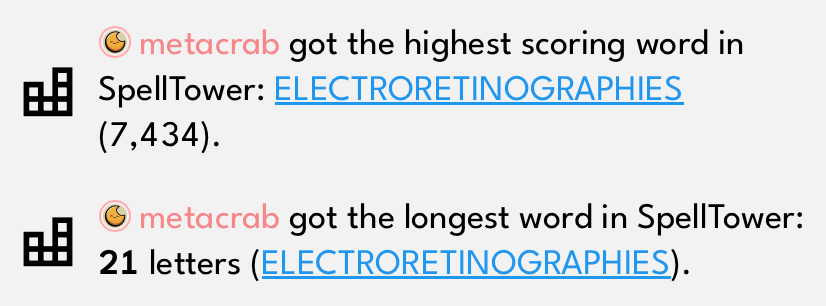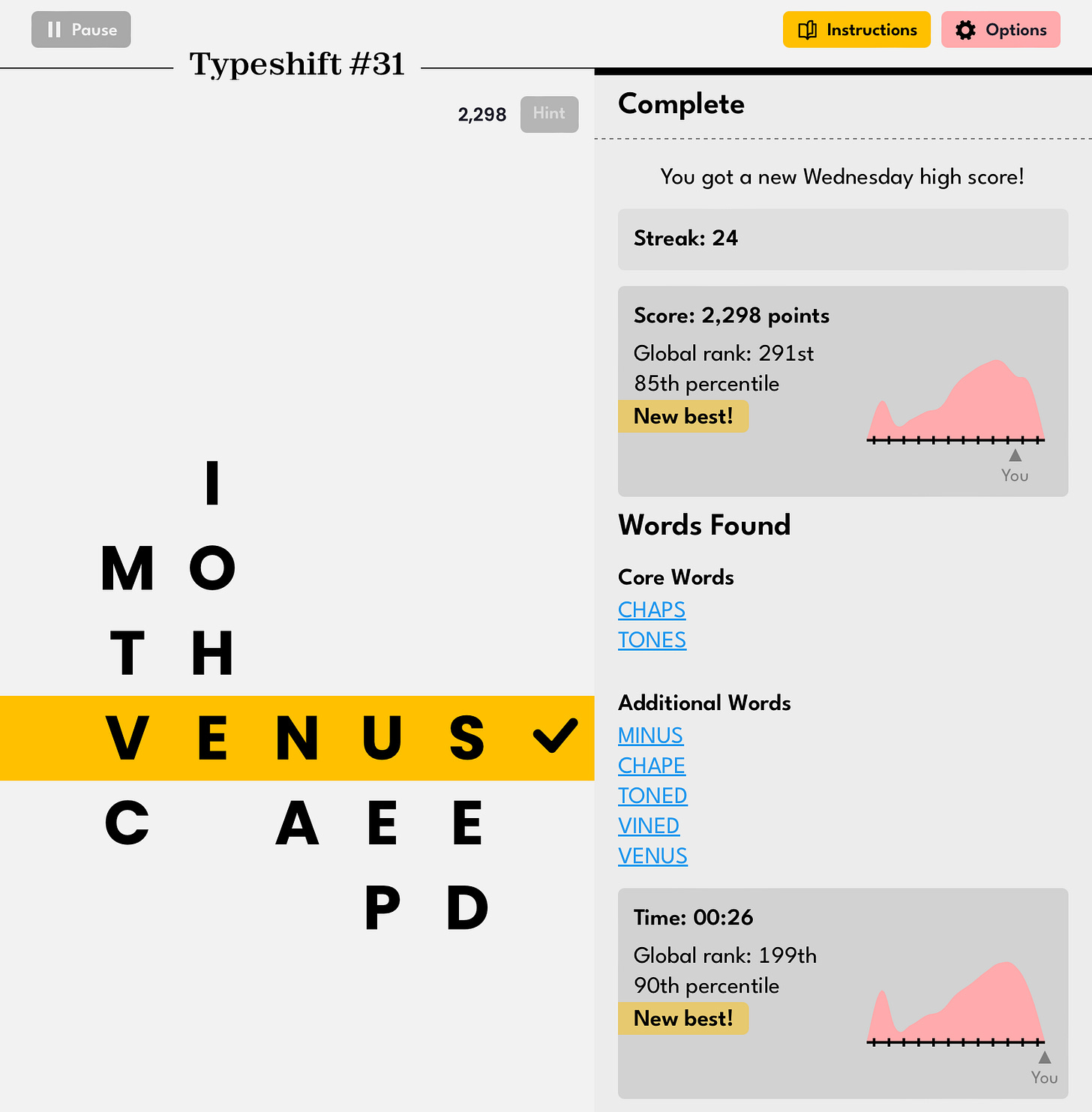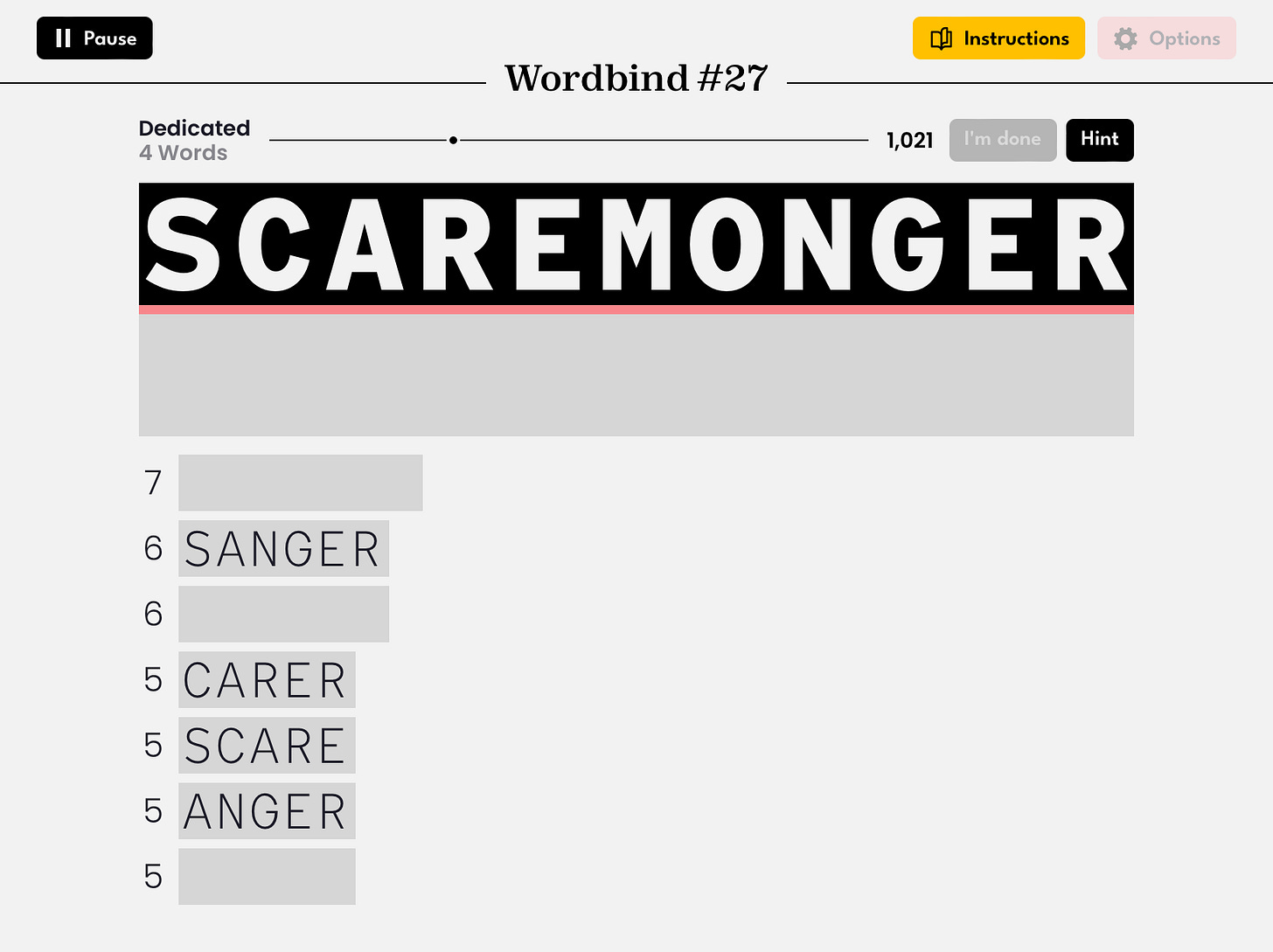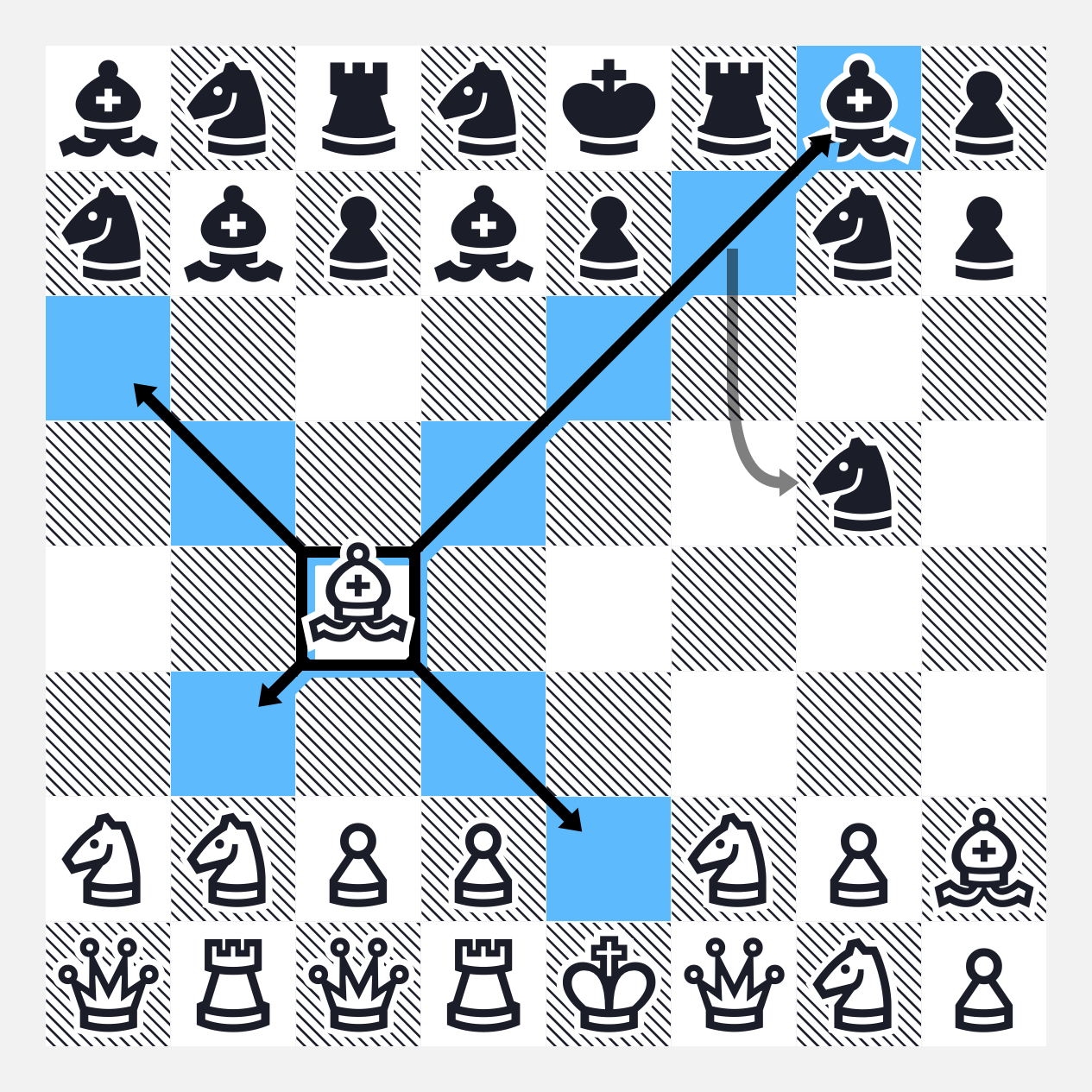Puzzmo
Delightful daily puzzling sullied by stressful gamification
Web
Free, with $40/year subscription
40 minutes per day
Puzzmo is a collection of six puzzles and minigames that refresh daily. Most are word-based, but a variation on chess and a shape-fitting puzzle broaden its reach, and social features allow paying players to compare their scores and performance.
The most obvious comparison to Puzzmo is The New York Times’ wildly popular Games section, which also includes lots of word-based puzzles and things like Sudoku; notably, they bought Wordle in 2022. NYT Games is included in some of the newspaper’s subscriptions but has also been bought standalone at $5/month or $40/year by over one million people.
But the better comparison is printed newspaper puzzle pages. These are still published and still have their devotees, albeit dwindling. Their charm – and Puzzmo’s, because it mimics them so closely – lies in how contained they feel. Here is your set of six puzzles a day, no more and no less, all displayed in full on a single (web)page. It’s a comforting mix of the familiar and the novel.
Well – it’s actually seven puzzles, because there’s always a bonus duplicate puzzle, so sometimes you’ll get two SpellTowers or two Fliparts instead of one. You never get two crosswords, probably because they cost more to make and take longer to play; and if you get two chess games, one of them will be much harder than the other. It takes me about 40 minutes to complete them all, though some will go much faster or skip puzzles they don’t like.
SpellTower
By connecting adjacent letters (including diagonally) to form words, you gain points and remove them from the board. The longer the word and rarer the letters, the more points you get. If you include a starred letter in a word, you double its score. Include a red letter, and its entire row will be removed. Form a words of five or more letters and the layer of letters surrounding it will also be removed.
Phew! SpellTower is one of the most game-like things in Puzzmo and originally launched in as a standalone app in 2011, now available as SpellTower+ on Apple Arcade. I played it a lot back in the day, but I find it a touch exasperating in this incarnation: the tower of letters is so large I’m often paralysed with indecision about how to start. It’s not that I can’t find long words in the tower, it’s that I know there’s a level of strategy where you engineer the tower to create really long words that I don’t have the patience for.
The reason I know this is because Puzzmo always tells me that other players, faced with the same tower, find way longer words than I do:
That this is bothersome is a problem for me – maybe I should get therapy – but it’s also a design problem that I’ll touch on later. The original SpellTower avoided this with a mode that added time pressure so you couldn’t spend too long crafting the perfect strategy; then again, it’s nice that this version doesn’t have time pressure, unlike some other Puzzmo games which can make me anxious.
All of which is to say, I think there’s plenty of room for improvement here, but I’m optimistic it’ll come: recently, the game updated so that finishing with two or fewer rows remaining gives you an extra 1000 points, and finishing with zero letters remaining gives you 2000 points. These massive bonuses give a tangible goal that all players can aim for, providing a bit more structure to the experience.

Typeshift
By moving columns of letters up or down, you form words in a horizontal line, turning the letters from grey to black, scoring points. Once you’ve turned all the letters black, the game is complete. There’s a neat hint system that shows moves the columns one at a time to clue you in to how to find any missing letters. That’s it!
Typeshift is an unpredictable game. It can take a surprisingly short or long amount of time to use all the letters, and I often have to reverse-engineer my way into a solution if I’m stuck with a grey letter in a weird place. I believe each game is designed so that all the letters can be used with a short set of “core words” that aren’t too uncommon, but I routinely complete Typeshift using weirder words or just hammering through combinations as fast as I can, which doesn’t feel very satisfying.
I do this because Typeshift’s scoring is mostly based on speed. It’s possible to finish some games in under 30 seconds, so there’s not much reward in taking your time. In fact, since you can see the Typeshift letters on Puzzmo’s home page even before you start the game, you can pre-find some – or all – of the words because a single timed second passes. Reader: I do this, but I promise it’s only for a couple words to start with, and only because I’ve convinced myself it’s the only way to compete against those dastardly players who probably pre-find them all.
Wordbind
You’re presented with a long word and need to find words inside it by using letters from left to right. You can also use the same letter twice in a row, so in this case, “SOONER” would be allowed:
Completing the first phase of the puzzle requires finding a list of words of specific lengths; here, it’s four 5 letter words, two 6 letter words, and one 7 letter word. This gives you a modest target to aim for, and again, a hint system reveals one letter at a time of missing words.
The second phase of the puzzle involves finding enough additional words to complete the progress bar at the top. You don’t need to do this, but it gets you more points. But that’s not all, because there can be yet more words to find even when the progress bar is full! This is a nice bit of design that gives players an honourable off-ramp when they feel like they’re done.
Like Typeshift, Wordbind is prone to cheating because you can see the whole word before you start.
Really Bad Chess
This is normal chess except your starting pieces are semi-randomised, so you’ll have four queens, three pawns, five knights, and so on; pieces still move like normal and the end goal is the same, though.
Because you’re given better pieces than your computer opponent, making trades aggressively (e.g. a bishop for a bishop) is a winning, if protracted, strategy. It’s also usually possible to checkmate within just a few moves because the computer isn’t that smart.
Really Bad Chess has quickly become one of my favourite Puzzmo games. I am not at all a fan of chess – the patience required to process the combinatorial explosion of possibilities or memorise starting patterns is beyond me – but because Really Bad Chess is easier and sillier and every game is very different, I find it much more fun.
Even more incredibly, it’s training me to become better at chess. Now that I’ve played thirty games in a row, I don’t rush headlong into simple trades; I check the most obvious repercussions, search for forks so I can pin down two pieces at once, and keep a lookout for what openings the computer might exploit. I don’t even mind it when the bonus puzzle is Really Hard Chess, where I think the pieces are more equal and the computer is a bit smarter. Frankly, my only problem with Really Bad Chess is that the computer sometimes makes foolish, unpredictable moves that wreck my plans.
Scoring appears to be based mostly on the number of moves you make before winning; you can always undo your last move or restart entirely, though this doesn’t reset your move count. I’m never tempted to speed through games, and to be honest I don’t even compare myself to other players because I know I’m not that good at chess, except for that one time I got the highest daily score, of course.
Really Bad Chess launched as a standalone app in 2016. Designer Zach Gage (also the lead of Puzzmo) said, “This could be perceived as an affront to chess,” but as people noted at the time, it really is a great learning tool.
Crossword
You know how crosswords work, I’m not going to explain them. These are “midi” sized, around 11x11 squares on average, and come in a range of difficulties. The clues are in the more literal, accessible US-style as opposed to the smug British cryptic crossword variety where you’re expected to learn the rules by osmosis.
I am traditionally not a crossword-enjoyer but something about Puzzmo has changed that in me. Perhaps it’s just that these crosswords are easier and the hints are well-constructed: the first hint for each clue show an additional, more obvious clue; then it’ll just reveal one letter at a time, all adding on extra time to your clock and reduce your score.
But that’s not it – I have access to NYT Games’ US-style crosswords and I’ve never been tempted to play them. Maybe it’s the size? Someone pointed out to me that the full-size NYT crosswords are much of a commitment than Puzzmo’s.
Or maybe it’s just completionism and the leaderboards; maybe I started playing them only to increase my total daily Puzzmo score and, improbably, ended up liking the. Maybe I’ve been played?! In any case, now I’m the person who’s memorised annoying and repeated clues like “SZA’s album” (CTRL) and “Penny Prez” (ABE).
Puzzmo’s crosswords are provided by AVCX, who seem to have a good business in supplying all sorts of companies. The US culture references and spelling still trip me up on occasion, which oddly means that the “easiest” crosswords are often the hardest.
Flipart
Fit a bunch of irregularly shaped pieces composed of square tiles into a box by rotating them from their fixed points. The challenge is that their starting positions are often heavily overlapped, and it’s not always obvious what shape a tile is in until you rotate it.

Flipart is very fast: standard-size games can be solved in well under 30 seconds, and even the bonus “Big Flipart” puzzles only take a couple of minutes. It’s satisfying to tidy up the tiles and figure out tactics like starting from the corners and edges. The only problem is that because the game is so fast, it feels almost too tense and disappointing when you make a mistake; even a few extra seconds on your clock or piece rotations is enough to see your score plummet down the leaderboards.
Puzzmo is designed to become a daily habit in a world where people don’t buy newspapers any more. It has an uncommonly good website that looks and works great on screens of all sizes, and since your state within a puzzle is saved in real time, you can easily start a game of Typeshift on your laptop, pause it for a Zoom call, then resume later on your phone (I find Typeshift better on touchscreens anyway because you can dual wield letter columns).
Its web-based nature matters to its business model, too. If Puzzmo were an app, it would give up 15-30% of its gross sales to Apple and Google, which is more than most business’ entire profit margin. I’m glad to see Puzzmo demonstrating the value of web-first experiences and I hope more creators follow it.
Buying a $40/year subscription gives access to two players, hides ads, and unlocks the archive of past puzzles, along with some exclusive games and puzzles. Subscribers also are included in leaderboards, get statistics about their play, and can create groups. This social side of Puzzmo is an important source of its growth, but also threatens to overwhelm what makes it fun.
Like the NYT’s Wordle and Spelling Bee, or popular trivia quizzes and crosswords more generally, much of the fun in daily puzzles lie in how they generate conversations from a common context, like weather in the UK; players rejoice or commiserate over an especially obscure word or a really fast solve. The standalone apps for SpellTower and Really Bad Chess are much cheaper and have far more puzzles, but they lack this social glue.
Gamification in Puzzmo
A lot of discussion in one of the groups I formed, Garbage Puzz, has been in puzzling out Puzzmo’s scoring systems. It seems that players are rewarded for getting things correct early, so that if two players solve the same crossword in 10 minutes but one of them got 95% of the clues right in the first minute while the other got them in the final minute, the former will get a much higher score. This makes sense and helps avoid tied scores, all of which end up being in four digits, which is a lot of digits.
What’s interesting about this is not so much the intricacies of scoring but the fact we spent so much time talking about it in the first place. Despite the disavowal of gamification in Puzzmo’s manifesto, gamification infuses every single aspect of the website:
Play is not kid stuff, or time-wasters, or gamification. Mindlessly matching gems while you watch tv is not play. Doing light math advertised to keep your brain elastic is not play. Work cannot be magically reformulated to become play. Play is its own thing. Play is engaging and all-encompassing. Play makes you feel light and free, even when it itself is deep and complex. Play is the companion of joy. …Play is a deep breath in and a slow release out.
Competitive stats from your friends and strangers are scattered liberally throughout the homepage, along with multiple leaderboards. Every time you finish a game, you see multiple graphs comparing your performance to everyone else’s, spelling out your percentile. Streak counts and weekly and monthly leaderboards encourage you to come back every day. Some of these can be hidden, but they’re all shown by default.
Puzzmo’s fixation on scores and leaderboards betrays a lack of consideration on how they can affect people negatively. I am a long time critic of gamification (I wrote a whole book about it!) as it’s most frequently used to manipulate people into spending more time on your product or service than they would have otherwise. I don’t think it has a place in games that are meant to be fun and joyful, as Puzzmo is. Personally, I get bummed out when I finish a puzzle and see I’m in the bottom 20%; and other people in my group are annoyed about being punished in leaderboards because they don’t like doing crosswords or apparent cheating from other players and groups.
There are other ways to commentate on players’ performance – the most obvious is prioritise personal trends, so you can see how you’re improving. But even that isn’t perfect, since it’s impossible for anyone to get better forever. It’s not like Puzzmo doesn’t know how to do this, either, as it will celebrate when you’ve found a longish word or completed a chess game with fewer pieces lost than usual, which isn’t exactly the same as fixating on “line go up”.
Of course, these things are harder to design and programme and calculate than scores – they literally cost more money in server time, too – but that’s the price of creating joy rather than anxiety, which is what I feel when competing in Typeshift and Wordbind against the spectre of genius/cheating strangers.
Puzzmo only launched a few weeks ago. It’s already changed in that time and I’m sure it’ll change much more in the coming months and years, adding more games and features.
I like it an awful lot, which is why I hold it to such a high standard. Its rampant, distracting gamification is a curious stumble from an otherwise fair and thoughtful website.











Zach Gage from Puzzmo was kind enough to quickly respond to this post in a thread with some suggestions on turning off competitive stats and different ways to play the games: https://x.com/helvetica/status/1726788019242312118?s=20
It's always metacrab. One thing I enjoy about Puzzmo is that the different puzzles appeal to/suit different abilities well. I can't do Really Bad Chess to save my life, and I'm not great at Spelltower, either, but I'm pretty good at the Crossword (proudly have yet to ever use a hint). But I do agree with you that the leaderboard can be discouraging, but I also kind of mentally gave up on it when I realized so many people cheat. If it's that important to them to "win," I'm never going to be competitive because I won't. So I use my position on the leaderboard relatively; am I in my usual zone? Worse? Better? That helps keep it more fun for me.